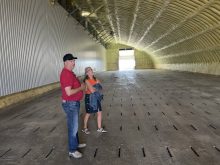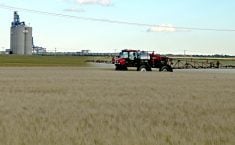A new container shipping facility that could be a boon to special crop growers and shippers is officially open for business.
Prince Rupert Fairview Container Terminal has the potential to break the rail logjam that often plagues Vancouver and disrupts exports of containerized special crops off the Prairies.
“This facility offers containers going to a part of the world that we need access to,” said Greg Cherewyk, director of transportation for Pulse Canada.
“There will be a huge volume of containers coming in from Asia and a huge volume leaving by the same corridor. It presents an obvious opportunity to fill those containers with agri-food products to ship out.”
Read Also

New coal mine proposal met with old concerns
A smaller version of the previously rejected Grassy Mountain coal mine project in Crowsnest Pass is back on the table, and the Livingstone Landowners Group continues to voice concerns about the environmental risks.
However, it will likely be some time before special crops are shipped out of Prince Rupert in any significant volume.
While the grand opening ceremonies were held last week, the first container vessel from Asia won’t arrive until Oct. 31.
The plan is to handle one vessel per week initially and then gradually increase the volume as the kinks are worked out.
The $170 million terminal is designed to handle 500,000 TEUs (twenty-foot equivalent unit containers) annually. A second phase, scheduled for completion by 2011, would bring the total to two million TEUs. By comparison, the port of Vancouver handled 2.2 million TEUs in 2006.
Barry Bartlett, director of communications for the Port of Prince Rupert, said maximizing the number of full containers shipped back westbound is a cornerstone of the port’s business plan.
“Specialty grain is clearly something we have been looking at.”
He said port officials will be working closely with shippers of special crops, along with other agricultural commodities like grain, pork, beef and chicken, to take advantage of the new opportunities.
“We see ourselves as providing a high-performance supply chain that can whisk your product all the way through the system with unparalleled reliability and velocity and without fear of congestion,” he said.
Cherewyk said while there is great potential for special crop shippers to use the port, there are a number of issues that have to be dealt with.
A crucial one is how many containers the shipping companies are willing to leave on the Prairies for transloading with export commodities like special crops.
“They like to have fast cycle times and move them back to Asia as quickly as possible, so we need a plan to limit the dwell time on the Prairies,” he said, likening it to a “pit stop” for race cars.
He said it will be up to Canadian National Railway and the shipping companies to decide how many containers they’ll be willing to load for the return trip, adding it may be necessary to build additional transloading facilities on the Prairies or perhaps at Prince Rupert.
There is also some concern that CN’s increased focus on Prince Rupert may affect its ability to serve other transportation corridors such as Vancouver.
The terminal project was jointly funded by Maher Terminals of New Jersey ($60 million), the government of Canada ($30 million), the government of British Columbia ($30 million), CN ($25 million for rail infrastructure) and the Prince Rupert Port Authority ($25 million).
















